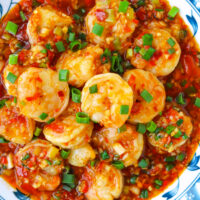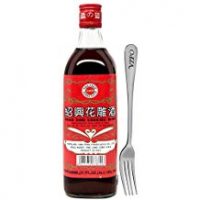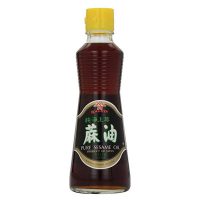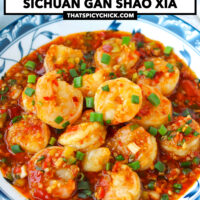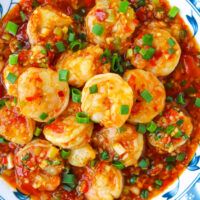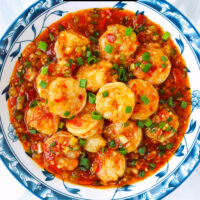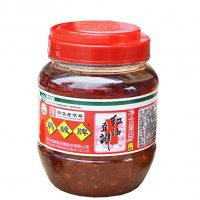 Buy Now →
Buy Now → Sichuan Dry-Braised Shrimp (Gan Shao Xia)
Juicy jumbo shrimp get briefly dry-braised in a lip-smacking and addictive garlicky and spicy sauce. This Sichuan Dry-Braised Shrimp is irresistibly delicious with a bowl of steamed rice!
- Prep Time: 15
- Cook Time: 10
- Total Time: 25 minutes
- Yield: 4 1x
- Category: Dinner
- Method: Stir-fry
- Cuisine: Sichuan
Ingredients
Scale
For the Shrimp Marinade:
- 250 grams / 9 ounces peeled and deveined Jumbo Shrimp (or prawns – size 16/20 preferred) – thawed if using frozen (see note 1)
- 1/8 TSP Kosher Salt
- 1/8 TSP ground White Pepper
- 1 TSP Shao Xing Rice Wine
- 1 TSP Potato Starch (or Corn Starch)
- ¼ TSP Sesame Oil
For the Sauce:
- 1 TBLS Low Sodium Light Soy Sauce
- 1.5 TBLS Shao Xing Rice Wine
- 2 TSP White Sugar
- ½ TSP Potato Starch
- 1 TSP Sesame Oil
- 1 TSP Pure Chili Oil (optional – without flakes/seeds – see note 2)
- 90ml / ¼ cup + 2 TBLS Water
For the Sichuan Dry-Braised Shrimp:
- 2 Spring Onion (Scallion/Green Onion) – finely chopped, white and light green parts separated from dark green parts
- 6 Garlic cloves – minced
- 1 TBLS minced Ginger
- 2 – 7 fresh Red Chilies (I used Thai Bird’s Eye chilies, but any small hot red chilies will work), to taste – finely chopped
- 3 TBLS Peanut Oil (or any neutral flavored cooking oil)
- ¾ TBLS Sichuan Pixian Dou Ban Jiang (Chili Bean Paste – see note 3)
- 1.5 TBLS Lao Gan Ma Pickled Chilies Sauce (or Sambal Oelek – see note 4)
Instructions
Prep:
- Marinate the shrimp: Rinse and pat-dry the shrimp. Add to a medium bowl, followed by the kosher salt, ground white pepper, low sodium light soy sauce, Shao Xing rice wine, potato starch and sesame oil. Mix well to coat, then set aside to marinate for 10-15 minutes.
- Make the sauce: Mix together the low sodium light soy sauce, Shao Xing rice wine, white sugar, potato starch, sesame oil, pure chili oil (if using), and water in a small measuring cup (for easier pouring) or bowl until combined well. Set aside.
- Prepare the fresh ingredients: Chop the spring onion (separate the white and light green parts from the dark green parts), garlic, ginger, and fresh red chilies as indicated in the ingredients section. Measure the pickled chilies sauce and use a small fine mesh strainer and press down with the back of a spoon to strain out the excess liquid. (A little liquid is fine, but too much will make the dish too salty).
For the Sichuan Dry-Braised Shrimp:
- Cook the shrimp. Heat 3 tablespoons peanut oil in a large wok (or a deep heavy bottomed frying pan) over medium-high heat. Once hot, add the marinated shrimp and allow to cook undisturbed for 30 seconds, then stir-fry for 30 seconds or until 80% cooked. Transfer to a clean plate or bowl and set aside. Scoop out and discard brown bits in the wok (if any).
- Sauté the dou ban jiang: Heat the oil in the wok over medium-low heat. Add the dou ban jiang and sauté for 20 seconds until shimmering and fragrant.
- Stir-fry the aromatics and pickled chilies sauce: Add the spring onion white and light green parts, garlic, ginger, fresh red chilies, and pickled chilies sauce. Stir-fry for 20-30 seconds until fragrant.
- Add the sauce: Give the sauce a quick stir with a spoon (to loosen up the starch at the bottom). Turn the heat back up to medium-high and pour in the sauce. Stir to combine and allow to bubble for 1 minute to let the flavors meld.
- Add the shrimp: Add the shrimp and toss continuously for 1 minute or until combined well and the sauce starts to thicken.
- Toss through spring onion greens: Toss through most of the spring onion dark green parts (reserve 1 tablespoon for garnish). Switch off the heat.
- To Serve: Transfer to a serving plate/dish and garnish with the reserved spring onion. Serve immediately with warm steamed rice.
Notes
- Shrimp. I used pre-peeled and deveined shrimp. If using shrimp or prawns that haven’t already been peeled and deveined, use double the quantity (500 grams / 1.1 pounds). The weight will be approximately halved once peeled and deveined.
- Pure Chili Oil. Use either a Chinese or Japanese chili oil (La-Yu) without sediment (flakes or seeds) for extra heat. Leave it out for a milder dish.
- Sichuan Pixian Dou Ban Jiang (Chili Bean Paste). This is a salty, spicy, and slightly sour paste made with chili peppers and fermented fava beans. It comes in plastic jars. Look for it in an Asian or Chinese supermarket. While you can use Lee Kum Kee brand chili bean sauce, note that it has several additional ingredients and is sweeter than authentic Sichaun Pixian dou ban jiang. You may need to use less white sugar to suit your taste preference is using it instead.
- Lao Gan Ma Pickled Chilies Sauce. Traditionally, pickled er jing tiao chilies (pao la jiao – 泡辣椒) are used in Chengdu and the Sichuan region for this dish. As they are not easy to find and spoil quickly when you do find them outside of China, I used Lao Gan Ma Pickled Chilies sauce. It has a salty, tangy and spicy flavor which I find is a great substitute. You can try to find it in an Asian or Chinese supermarket. Alternatively, grab a jar online. The closest readymade sauce substitute would be sambal oelek, a spicy chili sauce/paste from Indonesia. It is made with a chopped or crushed chilies, a little vinegar and salt. I recommend Huy Fong brand (same brand as the one for the popular Sriracha sauce) for this recipe if substituting. Or you can use a homemade sambal oelek. Mexican or Thai pickled chilies can also be substituted.
- Adjust spice level to taste. Use less (or omit) the fresh red chilies and chili oil for the stir-fry sauce. However, using less than the recommend amount of Lao Gan Ma Pickled Chilies sauce will result in a milder flavored dish that may be slightly too bland. If you do reduce the pickled red chilies amount, taste the sauce when it’s bubbling in the wok and add extra kosher salt if needed.
Nutrition
- Serving Size: 1 serving
- Calories: 238
- Sugar: 9.1g
- Sodium: 685.4mg
- Fat: 14.7g
- Saturated Fat: 2.4g
- Unsaturated Fat: 10.6g
- Trans Fat: 0g
- Carbohydrates: 17g
- Fiber: 2g
- Protein: 11.6g
- Cholesterol: 78.8mg
